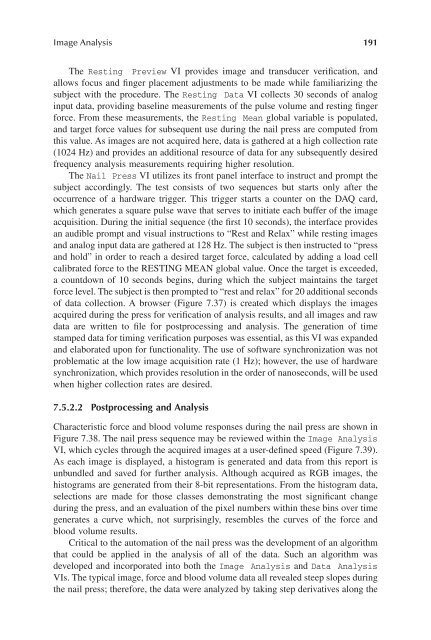Image Acquisitionand Proces
You also want an ePaper? Increase the reach of your titles
YUMPU automatically turns print PDFs into web optimized ePapers that Google loves.
<strong>Image</strong> Analysis 191<br />
The Resting Preview VI provides image and transducer verification, and<br />
allows focus and finger placement adjustments to be made while familiarizing the<br />
subject with the procedure. The Resting Data VI collects 30 seconds of analog<br />
input data, providing baseline measurements of the pulse volume and resting finger<br />
force. From these measurements, the Resting Mean global variable is populated,<br />
and target force values for subsequent use during the nail press are computed from<br />
this value. As images are not acquired here, data is gathered at a high collection rate<br />
(1024 Hz) and provides an additional resource of data for any subsequently desired<br />
frequency analysis measurements requiring higher resolution.<br />
The Nail Press VI utilizes its front panel interface to instruct and prompt the<br />
subject accordingly. The test consists of two sequences but starts only after the<br />
occurrence of a hardware trigger. This trigger starts a counter on the DAQ card,<br />
which generates a square pulse wave that serves to initiate each buffer of the image<br />
acquisition. During the initial sequence (the first 10 seconds), the interface provides<br />
an audible prompt and visual instructions to “Rest and Relax” while resting images<br />
and analog input data are gathered at 128 Hz. The subject is then instructed to “press<br />
and hold” in order to reach a desired target force, calculated by adding a load cell<br />
calibrated force to the RESTING MEAN global value. Once the target is exceeded,<br />
a countdown of 10 seconds begins, during which the subject maintains the target<br />
force level. The subject is then prompted to “rest and relax” for 20 additional seconds<br />
of data collection. A browser (Figure 7.37) is created which displays the images<br />
acquired during the press for verification of analysis results, and all images and raw<br />
data are written to file for postprocessing and analysis. The generation of time<br />
stamped data for timing verification purposes was essential, as this VI was expanded<br />
and elaborated upon for functionality. The use of software synchronization was not<br />
problematic at the low image acquisition rate (1 Hz); however, the use of hardware<br />
synchronization, which provides resolution in the order of nanoseconds, will be used<br />
when higher collection rates are desired.<br />
7.5.2.2 Postprocessing and Analysis<br />
Characteristic force and blood volume responses during the nail press are shown in<br />
Figure 7.38. The nail press sequence may be reviewed within the <strong>Image</strong> Analysis<br />
VI, which cycles through the acquired images at a user-defined speed (Figure 7.39).<br />
As each image is displayed, a histogram is generated and data from this report is<br />
unbundled and saved for further analysis. Although acquired as RGB images, the<br />
histograms are generated from their 8-bit representations. From the histogram data,<br />
selections are made for those classes demonstrating the most significant change<br />
during the press, and an evaluation of the pixel numbers within these bins over time<br />
generates a curve which, not surprisingly, resembles the curves of the force and<br />
blood volume results.<br />
Critical to the automation of the nail press was the development of an algorithm<br />
that could be applied in the analysis of all of the data. Such an algorithm was<br />
developed and incorporated into both the <strong>Image</strong> Analysis and Data Analysis<br />
VIs. The typical image, force and blood volume data all revealed steep slopes during<br />
the nail press; therefore, the data were analyzed by taking step derivatives along the



